Windows 10 Azure RDP Honeypot
Creating a Windows 10 machine on the Microsoft Azure Cloud and open the RDP Port to the internet to allow attackers to attempt to brute force the login.
-
Table of Contents
Summary
I’ve experimented with the cloud before (mainly Amazon AWS) and I wanted to branch out into Microsoft’s cloud platform. Microsoft Azure, but to see real-world attacks on infrastructure that I control.
In this project, I was able to create a log and analytics platform within Azure that enabled the collection of various data types but for this project it was Windows Security logs on the Windows 10 platform.
I was able to view brute force attacks in real-time and watch how people from various places in the world tried to guess my password for an account that doesn’t even have RDP rights within the computer.
In total, there were 158,966 attempts made to get into the Windows 10 Machine over a 10-day period 29/01/2025 - 07/02/2025 from about 30 different countries.
Definitions
- Brute Force
- The act of attempting multiple times to guess the correct credentials to gain
unauthorized or unintended accessinto a system.
- The act of attempting multiple times to guess the correct credentials to gain
- IP
- Stands for
Internet Protocol. This is the backbone of the modern internet and is the thing that allows for communication between networks. An IP Address will have 4 Octects and can range from 0-255. Example:192.168.0.150 | 5.254.33.111 | 245.77.83.2
- Stands for
- RDP
- Stands for
Remote Desktop Protocoland is the protocol that allows a user who is not physically in front of the machine to sign into that Windows computer and instead allowing sign-in through the network or internet. It’s like having the computer monitor anywhere, you just have to sign in.
- Stands for
- Azure Sentinal
- Azure Sentinal is
Microsofts integrated cloud SEIM solutionand can intake logs from various workspaces, read them, and compare them to a set of rules to determine if there is anysuspicious activity. People likeSOC Analysts are then able to log into the portal to look atcases, `incidents, create new rules, playbooks, send in KQL queries to gather log information, threat management and configuration for the intake oflogs, data connections and create automation rules.
- Azure Sentinal is
Method
- In my results, I want to find some of the top offenders and gather information on them and their habits
- Attributes like Geo-location
- IP Reputation on public Blacklists
- What user was attacked the most
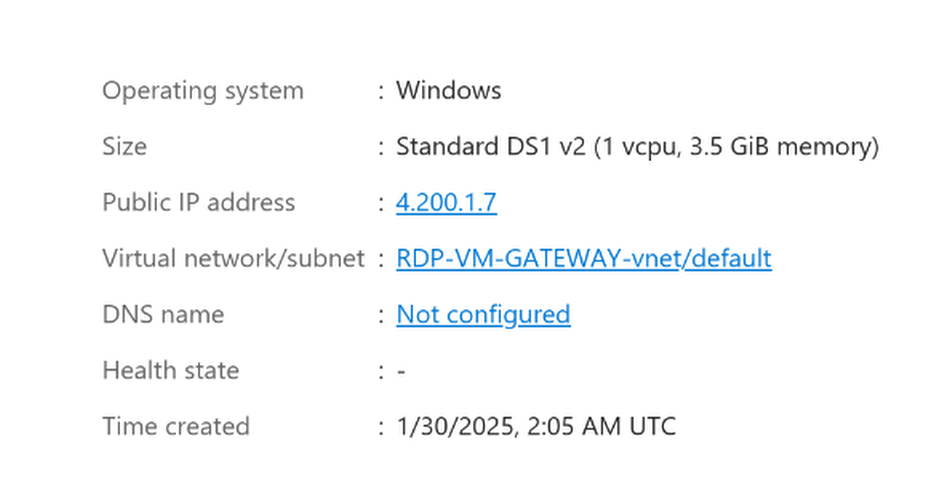
First we need to create the Windows machine and configure it to have a uncommon and complex username and password and a public IP address.
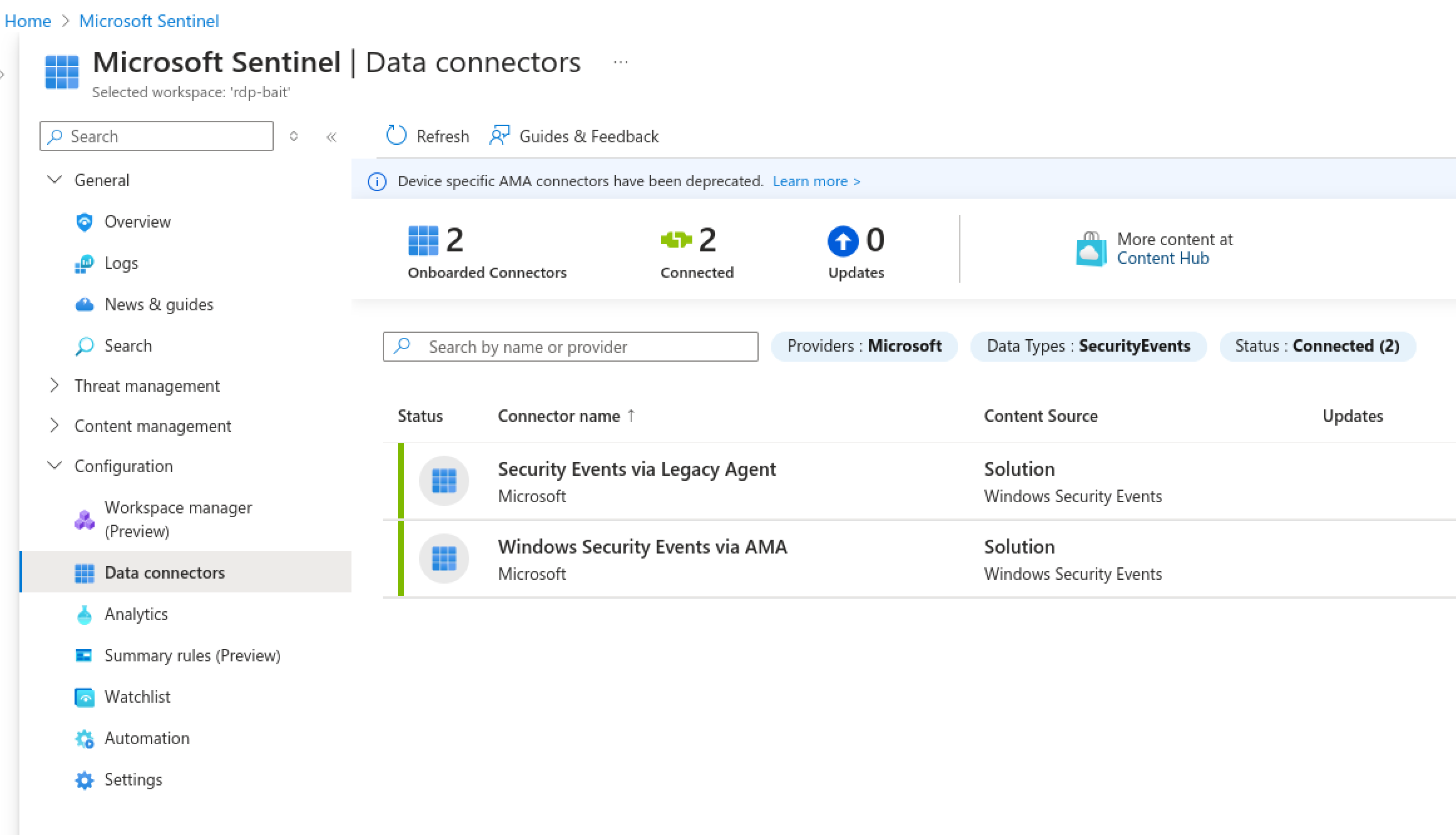
Once the VM is up and running we can create the Sentinal solution, logs, and analytics workspace and link it up to the Windows VM using the Data Connecters function
The data connectors function allows the Windows VM to send all of its logs to the Logs and Analytics workspace so Sentinal can read them.
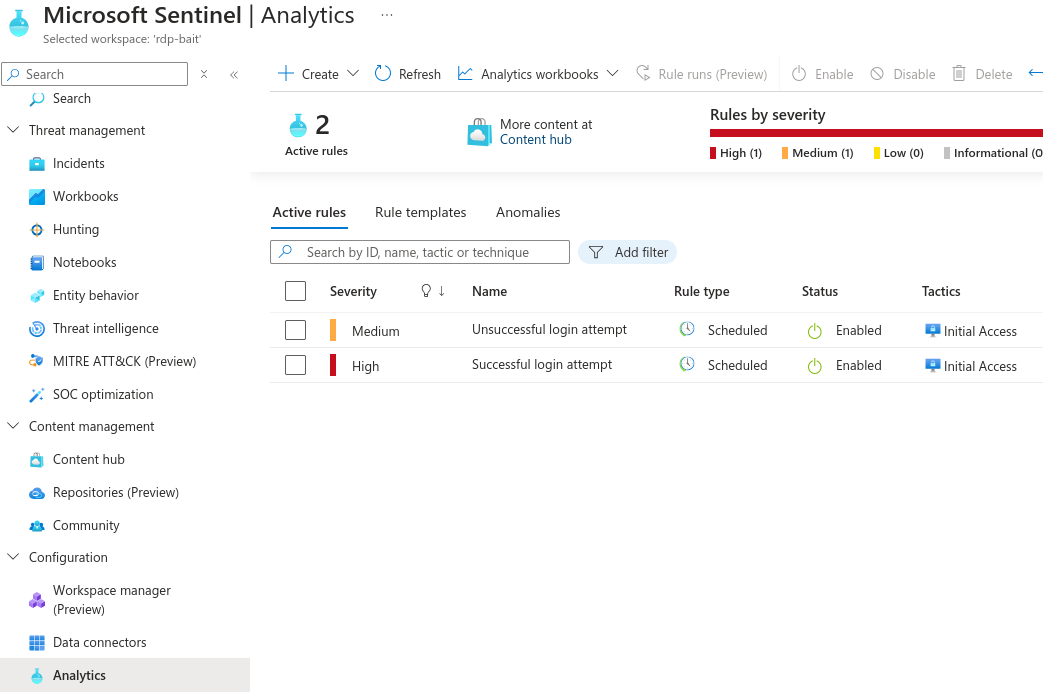
The Medium alert has the following KQL Query
//Checks in the security event logs and discards any logs that have the user "SYSTEM"
//and looks for event code 4625 which is a failed login attempt
SecurityEvent
| where Account !has "SYSTEM" and EventID == "4625"
The Successful login attempt rule has the same query but the EventID is “4624”.
The query will run every 5 minutes and if there are matches then it will generate an incident. These incidents can have automated responses, playbooks, and other automated tasks assigned to it.
Results
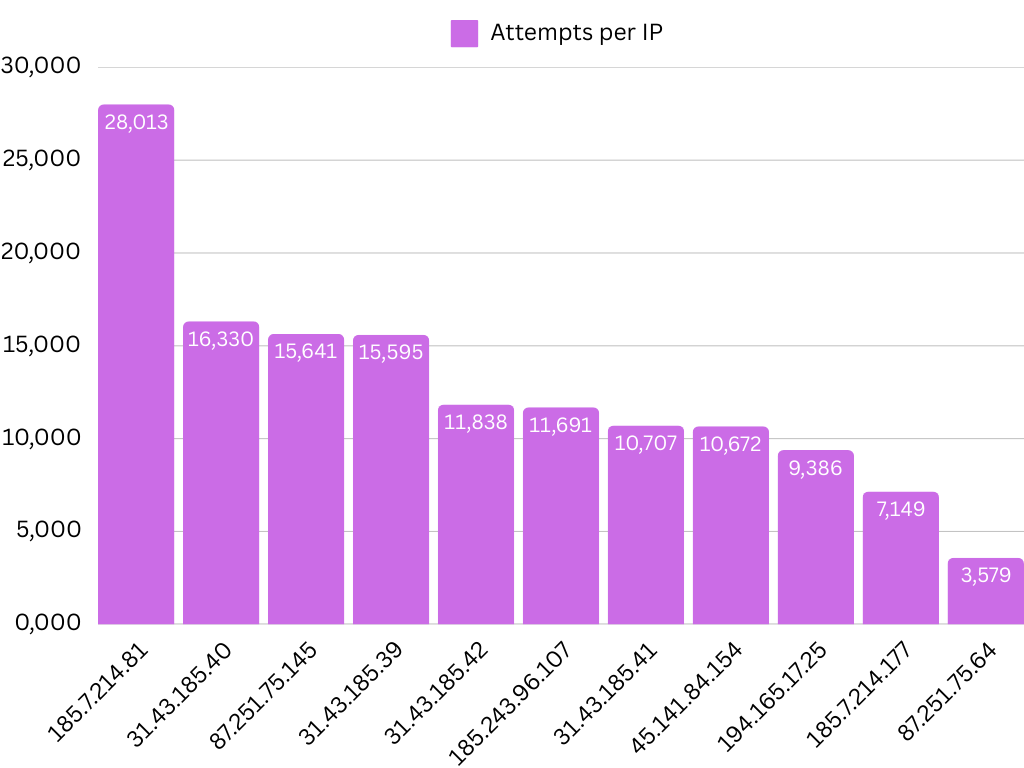
Here on the left is just a nice visualization of what IP addresses are attacking the machine. We can see that 185.7.214.81 was very dedicated to trying to get into the machine. But in the later graphs, we will see that this IP address in particular was going sort of “All or nothing” and sent in thousands of attempts in a short time frame then was never to be seen again.
Although I didn’t have any account restrictions or timeouts activated on the machine, it seems like to avoid or mask the fact that they are trying to brute force their way in, they throttle their pace.
- I think there are 2 possible reasons
- They are attacking multiple machines and have
limited bandwidth -
Avoiding detectioneither from anyWindows firewall, account, network policies, etc., or from anIDS
- They are attacking multiple machines and have
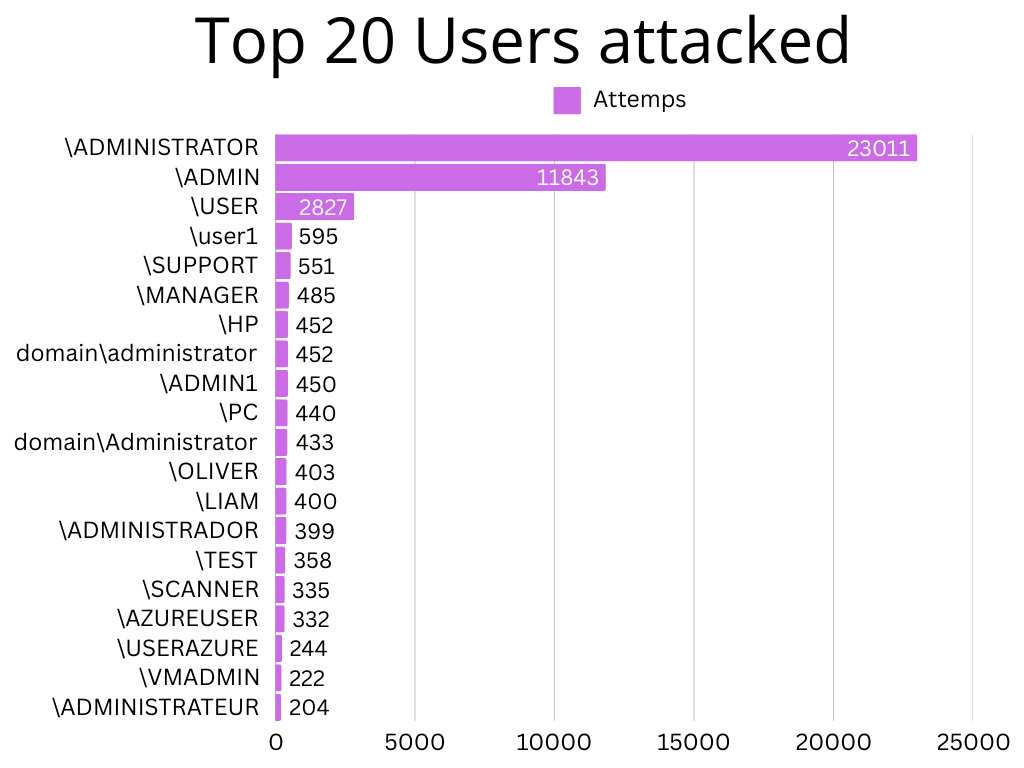
These are the most attacked accounts and they make sense. The default configuration on a Windows Server will have you create a password for the Administrator account and it’s unlikely that server administrators will want to change or disable the pre-made account as it’s the easier option. Although it is good practice to not only disable the Administrator account but to also restrict it from even having the ability to remotely connect but I’m guessing this isn’t as common as I’d like it to be. . .
- What I’m most interested in is the
domain\keyword- I want to test if using the
domain\<USER>will allow you to connect to a domain you don’t know. For example, if I had a domain calledCherryand I wanted to remotely log in to an account of theCherrydomain, could I just type inDOMAIN\ADMINISTRATORand get access to the domain administrator for Cherry? Or will I have to know the domain to sign into that domain administrator (CHERRY\ADMINISTRATOR)?
- I want to test if using the


- If you wanted to download the raw CSV data
The results-sorted.csv contains the extracted data from Azure Logs and Workspace analytics and has the time generated, account, account type, computer, activity, ip address, and logon type.
The duplicate-usernames.csv has a count column that displays the number of times that particular username was attacked and the account column next to it.
IP Address reputation and location
Next, I wanted to get the geographical data and other info from maybe their ISP. As I had over 100 IP addresses I decided to just write a script that uses the VirusTotal API to gather that info for me instead of manually going onto their website and having to search them by hand.
The code is pretty simple:
import requests
import time
with open("iteration-ip.txt", "r") as ip_file: # Grab the IP addresses in the file
IPs = []
IPs = ip_file.read().split("\n") # Split each IP address by a newline character
for i in range(len(IPs)): # loop
url = "https://www.virustotal.com/api/v3/ip_addresses/" + IPs[i] # URL for the needed API + the current IP
headers = {
"accept": "application/json",
"x-apikey": "<API-KEY>" # Add in your API key
}
response = requests.get(url, headers=headers) # Send the request
print(IPs[i], " Had a response code of ", response) # feedback in terminal
time.sleep(0.5) # Make sure the API doesnt block us for too many requests
filename = IPs[i] + ".json" # If you want the json to be human readable, in vscode or codium
# use the hotkey CTRL + SHIFT + I to format it
with open(filename, "w") as f:
f.write(str(response.text)) # save the output in a json file named with the IP
Now if I ran that script I would start getting an output that looks like this:
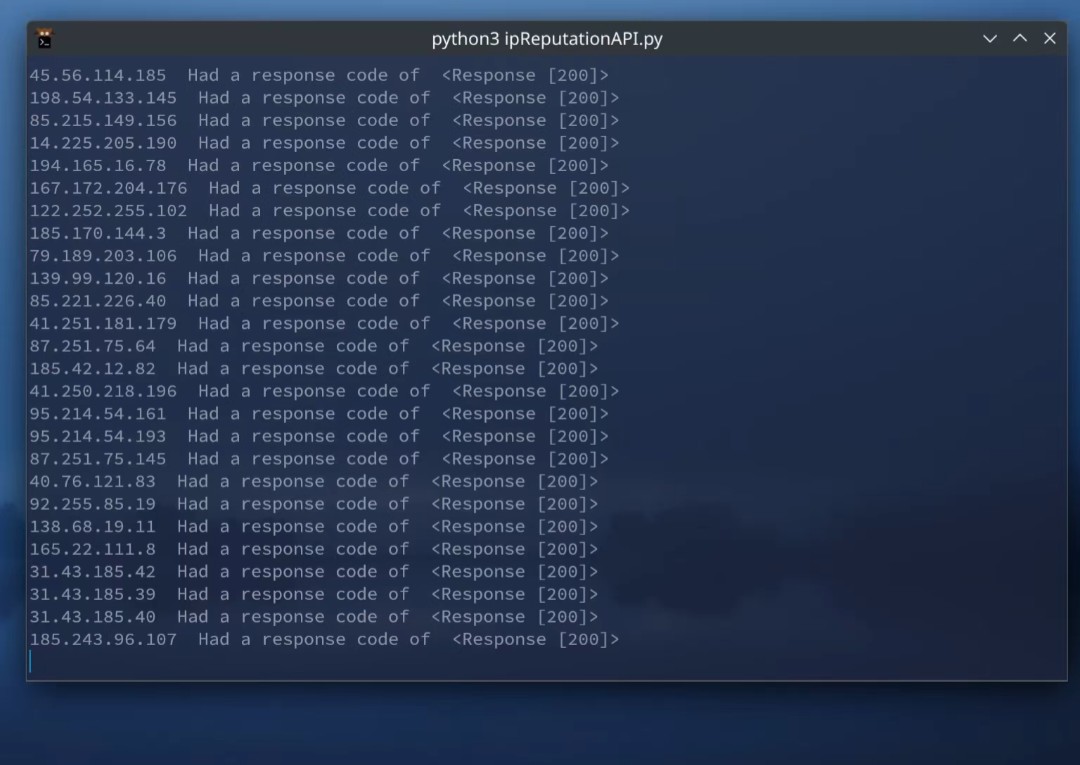
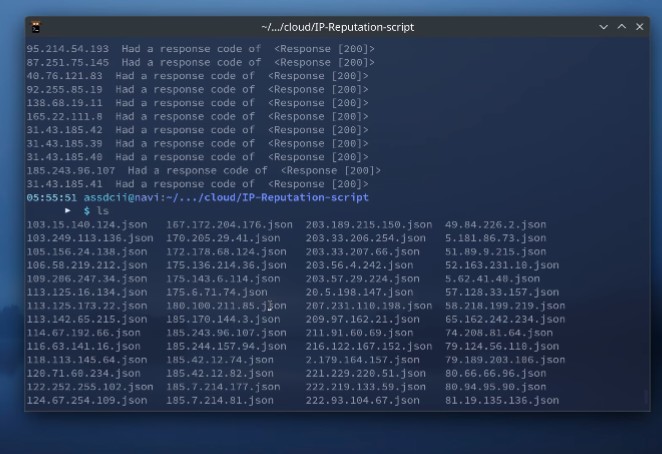
This is a sample of the JSON data I got from VirusTotal.
{
"data": {
"id": "185.7.214.81",
"type": "ip_address",
"links": {
"self": "https://www.virustotal.com/api/v3/ip_addresses/185.7.214.81"
},
"attributes": {
"last_https_certificate_date": 1637657634,
"asn": 207566,
"last_analysis_results": {
"Acronis": {
"method": "blacklist",
"engine_name": "Acronis",
"category": "harmless",
"result": "clean"
},
//===================== CUT =====================\\
},
"ZeroFox": {
"method": "blacklist",
"engine_name": "ZeroFox",
"category": "undetected",
"result": "unrated"
}
},
"last_analysis_stats": {
"malicious": 9,
"suspicious": 2,
"undetected": 28,
"harmless": 55,
"timeout": 0
},
"as_owner": "Chang Way Technologies Co. Limited",
"last_modification_date": 1739509942,
"country": "RU",
"reputation": -1,
"regional_internet_registry": "RIPE NCC",
"jarm": "29d29d20d29d29d00029d29d29d29decf7fca7fb071cf5a94949fbcc16ef69",
"continent": "EU",
"network": "185.7.214.0/24",
"last_analysis_date": 1739134408,
"total_votes": {
"harmless": 0,
"malicious": 1
},
"whois_date": 1736598507
}
}
This is a cut of the JSON data that I was able to receive but I cut out a lot of the garbage and useless data from it like http certificates and RSA public keys that take up too much space on this page.
-If you want the data from all of the IP addresses I put it in a zip file along with the IPs in a list and the file version of the script - IP-Reputation-script.zip
This data contained things like information on the ISP, like contry, company, encryption keys etc.
Top 10 offenders
1
maybe? - data - Attempts - 28,013 - Contry - Russian Federation (RU) - State/City - Moskva/Moscow - ISP - Chang Way Technologies Co. Limited - Blacklist/Rep - 9/79 - Tor/Proxy/VPN - No (? should be yes) - Services - VPN Server2. 31.43.185.40
</br> - Attempts - 16,330 - Contry - Netherlands - State/City - Noord-Holland/Amsterdam - ISP - FOP Dmytro Nedilskyi - Blacklist/Rep - 2/79 - Tor/Proxy/VPN - No - Services - Datacenter3. 87.251.75.145
- data - Attempts - 15,641 - Contry - Netherlands - State/City - Noord-Holland/Amsterdam - ISP - Aleksandr Valerevich Mokhonko - Blacklist/Rep - 9/79 - Tor/Proxy/VPN - No - Services - Datacenter4. 31.43.185.39
- data - Attempts - 15,595 - Contry - Netherlands - State/City - Noord-Holland/Amsterdam - ISP - FOP Dmytro Nedilskyi - Blacklist/Rep - 2/79 - Tor/Proxy/VPN - No - Services - Datacenter5. 31.43.185.42
- data - Attempts - 11,838 - Contry - Netherlands - State/City - Noord-Holland/Amsterdam - ISP - FOP Dmytro Nedilskyi - Blacklist/Rep - 1/79 - Tor/Proxy/VPN - No - Services - Datacenter6. 185.243.96.107
- data - Attempts - 11,691 - Contry - United States (USA) - State/City - New York/New York City - ISP - Demenin B.V. - Blacklist/Rep - 1/79 - Tor/Proxy/VPN - No - Services - Datacenter7. 31.43.185.41
- data - Attempts - 10,707 - Contry - Netherlands - State/City - Noord-Holland/Amsterdam - ISP - FOP Dmytro Nedilskyi - Blacklist/Rep - 2/79 - Tor/Proxy/VPN - No - Services - Datacenter8. 45.141.84.154
- data - Attempts - 10,672 - Contry - Russian Federation (RU) - State/City - Sankt-Peterburg/Saint Petersburg - ISP - Media Land LLC - Blacklist/Rep - 1/79 - Tor/Proxy/VPN - No - Services - Datacenter9. 194.165.17.25
- data - Attempts - 9,386 - Contry - Belgium - State/City - Brussels Hoofdstedelijk Gewest/Brussels - ISP - FlyServers S.A. - Blacklist/Rep - 7/79 - Tor/Proxy/VPN - True (Hosting Provider) - Services - VPN Server10. 185.7.214.177
- data - Attempts - 7,149 - Contry - Russian Federation (RU) - State/City - Moskva/Moscow - ISP - Chang Way Technologies Co. Limited - Blacklist/Rep - 7/79 - Tor/Proxy/VPN - No (? should be yes) - Services - VPN ServerFrom the top 10 attackers:
- Top 10 attackers
- 3 where from the Russian Federation
- 5 where from the Netherlands
- 1 was from the United States and
- 1 was from Belgium
With this new data in json format, I was able to generate a cool-looking interactive heatmap of what countries all of these IPs belonged to.
This heatmap proved to confirm another of my guesses at the start of this project, that it would mostly be developed countries that are spraying passwords everywhere trying to get lucky.
Heatmap
To see the descriptive text in the embeded link, you have to highlight the text or turn on light mode as the color is of the text is black
Conclution and Preventions
So, we learned that if you have a server exposed to the internet, no matter if you think that you have hidden it, never share its IP address, and don’t tell anyone that it exists, it will still get targeted. So how can we prevent this from happening?
Cyber Security Frameworks
- Mitre ATT&CK Brute force
- On attack.mitre.org there is a page in the
Credential Accesssection calledBrute Forceand explains some useful definitions likePassword Guessing, Password Cracking, Password Spraying, and Credential Stuffing. - It explains mitigation techniques like
Multi-Factor Authentication, Password Policies, and User Account Managementand how to utilise them to defend your system effectively. - It has Detection mechanisms and explains how to collect the necessary data and process it to get valuable information and determine whether or not there are possible brute-forcing or credential exfiltration happening.
- It contains lots of
referenceson how it has gathered its information and you can access them to gather more information and strategies on how to mitigate this attack
- On attack.mitre.org there is a page in the
- If you are trying to prevent attacks on a
Web App, thenOWASPcould help owasp.org- OWASP gives an in-depth guide to regular users on the description and risk of how brute forcing can affect a company and a guide to penetration testers on how to find and exploit this.
- The
Essential Eightby theAustralian Cyber Security Centre(ACSC) essential eight- Multifactor Authentication
- Restrict administrative privilege
With multifactor Authentication even if someone can get a user password they are not able to get into the account because they have to complete another challenge like entering a 6-digit OTP code or E-Mail verification.
Restricting Administrative privileges can also help a company, if a user that gets breached doesn’t have MFA then it will be the account policies assigned to that user that will stump the attacker, with minimal privileges then an attacker isn’t able to access critical applications or data reducing the risk.
If every company in Australia has not already, they should start adopting this framework as it is becoming the new Australian standard.
Preventions
If we take a look at the Mitre ATT&CK and the Essential Eight documents on brute force attacks, then can determine that 2 things can stop attackers extremely effectively.
- MFA
- Access Controls
MFA or Multi-factor Authentication will stop almost all attacks regarding straight brute forcing and guessing credentials. Even if someone gets a user username and password they have to go through another layer of security that is often extremely hard to get through.
Having good Access Controls not only for the user but for the devices is also good practice, if you have a machine with an RDP port open to the internet, then maybe restrict what IP addresses can access that port by having whitelists. Having blocklists for IP addresses that are known to be malicious can also improve security and access controls can also help a company if a user does manage to get breached by limiting what they can even access in the first place.